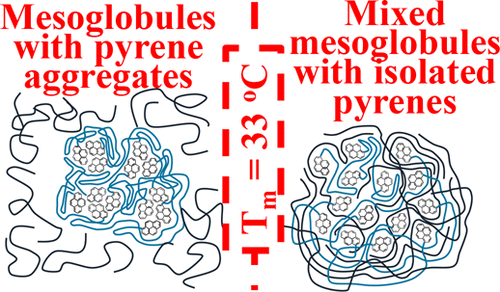当前位置:
X-MOL 学术
›
Macromolecules
›
论文详情
Our official English website, www.x-mol.net, welcomes your
feedback! (Note: you will need to create a separate account there.)
Temperature-Controlled Interactions between Poly(N-isopropylacrylamide) Mesoglobules Probed by Fluorescence
Macromolecules ( IF 5.1 ) Pub Date : 2018-02-23 00:00:00 , DOI: 10.1021/acs.macromol.8b00003 Michael Andrew Fowler 1 , Jean Duhamel 1 , Xing Ping Qiu 2 , Evgeniya Korchagina 2 , Françoise M. Winnik 2, 3
Macromolecules ( IF 5.1 ) Pub Date : 2018-02-23 00:00:00 , DOI: 10.1021/acs.macromol.8b00003 Michael Andrew Fowler 1 , Jean Duhamel 1 , Xing Ping Qiu 2 , Evgeniya Korchagina 2 , Françoise M. Winnik 2, 3
Affiliation

|
The temperature-dependent behavior of aqueous solutions composed of a small amount of monodisperse poly(N-isopropylacrylamide) (PNIPAM) labeled at one or both ends with pyrene (Pyn-PNIPAM with n = 1 or 2) and a 10-fold excess of a nonfluorescent poly(N-isopropylacrylamide) (PNIPAM(22K), Mn = 22 000 g/mol) was characterized using steady-state (SSF) and time-resolved (TRF) fluorescence. Turbidimetry studies indicated that all solutions exhibited two temperature-induced transitions: one at Tc, the cloud point of the pyrene-labeled polymers, and one at Tc22, the cloud point of PNIPAM(22K). These two transitions were also inferred from a decrease in the excimer-to-monomer fluorescence intensity ratio, namely, the IE/IM ratio, obtained from SSF spectra. TRF decays of the pyrene monomer were acquired and fitted with a sum of exponentials to obtain the number-average lifetime ⟨τ⟩. Plots of ⟨τ⟩ versus temperature also showed transitions at Tc and Tc22. The changes in behavior observed at Tc for both IE/IM and ⟨τ⟩ were consistent with those observed for solutions of solely Pyn-PNIPAM samples. The transitions found at Tc22 for the Pyn-PNIPAM solutions with PNIPAM(22K) were not observed in aqueous solutions of Pyn-PNIPAM without PNIPAM(22K). They were explained by invoking substantial mixing of labeled and unlabeled chains as temperature exceeded Tc22. This mixing could only occur if the mesoglobules composed of labeled chains were not “frozen” at temperatures above Tc22 despite forming stable entities in this temperature range. This phenomenon was rationalized by considering the difference in the characteristic reptation time of the chains found in a Pyn-PNIPAM and PNIPAM(22K) mesoglobule at temperatures larger than Tc22.
中文翻译:

荧光探测的聚(N-异丙基丙烯酰胺)介球之间的温度控制相互作用
由少量在一端或两端用pyr标记的单分散聚(N-异丙基丙烯酰胺)(PNIPAM)组成的水溶液的温度依赖性行为(Py n -PNIPAM,n = 1或2),且过量10倍使用稳态(SSF)和时间分辨(TRF)荧光对非荧光聚N异丙基丙烯酰胺(PNIPAM(22K),M n = 22000 g / mol)进行表征。比浊法研究表明,所有溶液均表现出两种温度诱导的转变:一种在T c处,the标记的聚合物的浊点,另一种在T c22处。,即PNIPAM(22K)的浊点。这两个转变也从在准分子与单体的荧光强度比的降低推断,即我È /我中号从SSF光谱获得比。获得the单体的TRF衰变,并使其与指数求和,以得到数均寿命⟨τ⟩。⟨τ⟩与温度的关系图也显示了在T c和T c22处的转变。在观察到的行为更改牛逼Ç两个我Ë /我中号和⟨τ⟩是与全权PY的解决方案观察一致ñ-PNIPAM样本。在没有PNIPAM(22K)的Py n -PNIPAM水溶液中,未观察到具有PNIPAM(22K)的Py n -PNIPAM溶液在T c22处发现的跃迁。当温度超过T c22时,通过充分混合标记和未标记链来解释它们。尽管在此温度范围内形成稳定的实体,但只有在T c22以上的温度下未“冻结”由标记链组成的介球时,才会发生这种混合。通过考虑Py n -PNIPAM和PNIPAM(22K)中球中温度高于30°C的链的特征复制时间的差异,可以合理化此现象。T c22。
更新日期:2018-02-23
中文翻译:

荧光探测的聚(N-异丙基丙烯酰胺)介球之间的温度控制相互作用
由少量在一端或两端用pyr标记的单分散聚(N-异丙基丙烯酰胺)(PNIPAM)组成的水溶液的温度依赖性行为(Py n -PNIPAM,n = 1或2),且过量10倍使用稳态(SSF)和时间分辨(TRF)荧光对非荧光聚N异丙基丙烯酰胺(PNIPAM(22K),M n = 22000 g / mol)进行表征。比浊法研究表明,所有溶液均表现出两种温度诱导的转变:一种在T c处,the标记的聚合物的浊点,另一种在T c22处。,即PNIPAM(22K)的浊点。这两个转变也从在准分子与单体的荧光强度比的降低推断,即我È /我中号从SSF光谱获得比。获得the单体的TRF衰变,并使其与指数求和,以得到数均寿命⟨τ⟩。⟨τ⟩与温度的关系图也显示了在T c和T c22处的转变。在观察到的行为更改牛逼Ç两个我Ë /我中号和⟨τ⟩是与全权PY的解决方案观察一致ñ-PNIPAM样本。在没有PNIPAM(22K)的Py n -PNIPAM水溶液中,未观察到具有PNIPAM(22K)的Py n -PNIPAM溶液在T c22处发现的跃迁。当温度超过T c22时,通过充分混合标记和未标记链来解释它们。尽管在此温度范围内形成稳定的实体,但只有在T c22以上的温度下未“冻结”由标记链组成的介球时,才会发生这种混合。通过考虑Py n -PNIPAM和PNIPAM(22K)中球中温度高于30°C的链的特征复制时间的差异,可以合理化此现象。T c22。









































 京公网安备 11010802027423号
京公网安备 11010802027423号